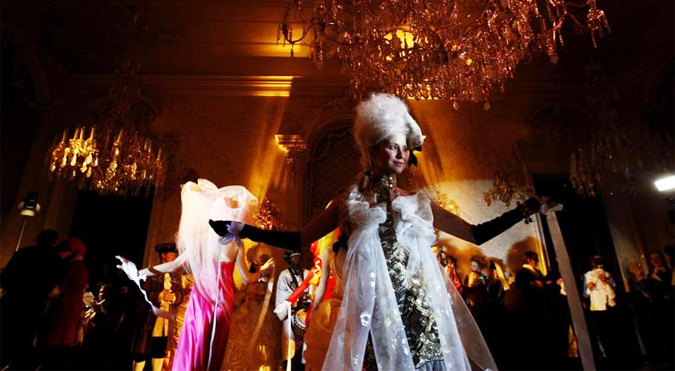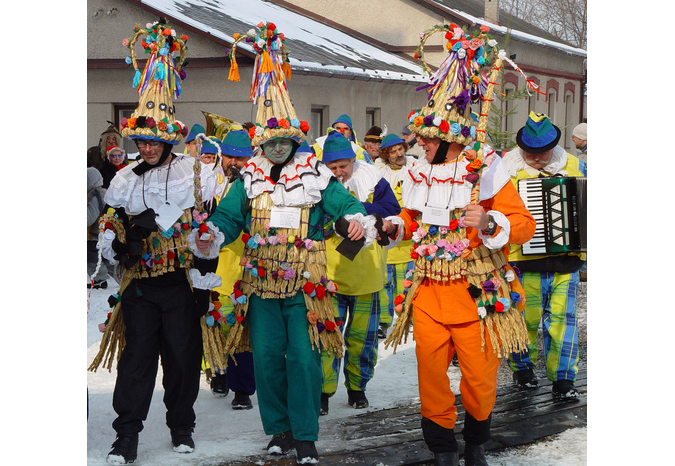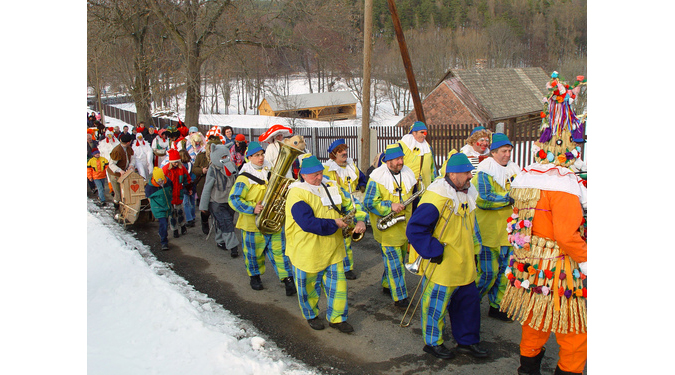To get one’s fill of eating and amusement ahead of the Lenten fast – those were the main aims of the Czech carnival tradition known as “Masopust”, extending from Epiphany till Ash Wednesday. This tradition originated in the Middle Ages and was quickly adopted by all strata of the population – from the poorest to the rich, in the countryside and in the cities. The Masopust of today, too, offers especially abundance and merriment and is celebrated in many places across the Czech Republic.
Prague, too, has returned to the longstanding tradition
The traditional whirl of great Masopust festivals will again enliven the capital city. The “Carnevale Praha” Festival begins on 10 February and continues until 21 February. A carnival scene on the Old Town Square will come alive with costumes, while other events will take place in theatres, galleries, museums, palaces and schools. In the partner restaurants, you will find Masopust specialities on the menus. However, certain events can only be attended incognito, i.e. in an historical costume and mask. It is therefore advisable to purchase or borrow these necessary accessories in advance. The event’s organisers, too, have borne this in mind. (www.carnevale.cz)

Carnevale Bohemia
The Masopust menu starts with pork
During the entire Masopust season, pig butchering traditionally abounded in the villages, as winter was an ideal time for filling the larders with meat. During this year’s Masopust celebrations you also can look forward to a festival of pork – boiled pork, black pudding, blood sausages or head cheese. The fourth annual Masopust of Hustopeče, which will take place on Saturday, 18 February, will serve up plenty of pork delicacies along with pleasant entertainment. It will include a costume parade and Franta Uher, a folk storyteller. The Masopust of Hustopeče has traditionally been a charity event; you can contribute by, for example, making a voluntary contribution for soup, purchasing a glass of wine or participating in the auction of wines from local winemakers. (www.hustopecskymasopust.cz)
Meat, wine, spirits and sweets are a must
Our housewives always excelled in the art of creating delicacies from a few common ingredients, and this is true also of the savoury dishes during Masopust. In this period, the classic sauces – which have remained the pride of Czech cuisine up to the present day – are prepared and include the “svíčková” cream sauce, as well as horseradish, tomato, dill and mushroom sauces. The so-called Masopust casserole was also a favourite meal, consisting of a pork goulash from the shoulder or leg and liver. Poorer families enjoyed fried crackling pancakes. Nor will those who take pleasure in sweets go away unsatisfied. Masopust donuts and “God’s Graces” pastries were fried in sizzling fat. You will be able to taste some of these specialties during Masopust celebrations at the Wallachian Open Air Museum in Rožnov pod Radhoštěm on Saturday, 11 February. Each year, a competition to select the best Wallachian sausages and Wallachian head cheese is held here as part of the Masopust celebrations. (www.vmp.cz)

Masopust in Příbram
No costume parade is complete without the bear
Costumed parades comprise an integral part of the Masopust celebrations. While there never were any special rules, these processions always had one thing in common. They always concluded the merry period of Masopust, and therefore they were held on the Masopust Tuesday before Ash Wednesday. With accompanying musicians, the masked entourage would travel from house to house performing various merry deeds to entertain the onlookers. The favourite costume was that of the bear, the symbol of fertility. The procession usually culminated in a masquerade celebration, which traditionally ended at midnight, at which time all the instruments had to stop playing and the 40 days of fasting began. Masquerade processions and ensuing masquerade balls can be attended in many places this year. Exactly in the spirit of the folk tradition, Masopust merrymaking will be conducted at Dlask’s farmstead in Dolánky near Turnov on Saturday, 11 February. The parade will include a bear handler, Bacchus, a traditional granny-with-a-basket, a barber and a number of other traditional costumes. (www.muzeum-turnov.cz) The renewed folk tradition of Masopust celebration with a typically bright-coloured parade of costumes, accompanied by street theatre, jugglers and musicians, and with a wealth of eating and dancing, will surely attract many tourists into Český Krumlov during 18–21 February. (www.ckrumlov.info)
Masopust festival in Bohutín helped to fund a new fire engine
Two kilometres south of Příbram lies the mining village of Bohutín, where a Masopust celebration will be held for the 85th time. It began almost by accident. The first costume parade consisted of just a few people who put on masks and walked through the village in order to collect contributions from the locals for a new fire engine. In the past, even complex floats on various themes were in the parade. On the platforms of various vehicles, one could see a surgery in process, a magical mill for grinding old women back to youth, even a circus. The procession was sometimes joined also by horse carriages carrying the Masopust wedding party. People believed that couples wed during Masopust would enjoy happy and long lives together. While the floats gradually disappeared and were replaced by street theatre, Masopust found its permanent place in Bohutín’s calendar of cultural events and everyone believes the masquerade will still be marching through the town after even 100 years. This year, it will be held on 21 February. (www.obec-bohutin.cz)

Masopust in Příbram
The Moravian Fašank originated as a distortion of the German word Fasching
In Moravia, Masopust is called Fašank. Not only do the Moravians have a different name, but also a number of local customs and traditions originated there. The Masopust celebrations nevertheless had one thing in common – our ancestors spent the end of winter in entertainment and joyful merrymaking. It even had a special proverb: One who works too much during Masopust will be sick because of it come summer.
The preparations for this year’s Fašank in Lednice, which will take place on Saturday, 18 February, began already in autumn. The people there are fully attentive to the fact that merrymaking must be properly prepared if it is to consist of good food, fantastic drinks and joyful atmosphere. The yard of the winery must be filled with fried donuts, boiled pork, sausages and home-made spirits! The wine brandy will flow! (www.lednickyfasank.cz) For the third time, the Masopust parade also will pass through the centre of Olomouc. The Masopust tradition was revived thanks to the Waldorf School in Olomouc, which has been promoting Masopust since the school’s founding in 2004. It began with events inside and around the school, and it has been gradually increasing the scope of its activities. This year’s procession will be held on 17 February. (www.waldorf-olomouc.cz)
Vacation sacrificed to Masopust
In Postřekov near Domažlice, Masopust is an immense event, celebrated by four days of merriment and practically all the inhabitants of the town take vacation for it. There is a masquerade ball on Saturday, a folk costume procession on Sunday and a “bouquet” ball in the evening. On Monday there is a “grannies’ ball”, which originally could not be attended by unmarried youths, but you will surely be admitted today, even if you are not married. The Tuesday costumed procession is the highlight of the Masopust celebration, complete with the bear with its handler, a mare and granny-with-a-basket. This year the Masopust celebrations in Postřekov will be held during 18–21 February. (www.obecpostrekov.cz)
PARTNER ARTICLE
Related articles












 Reading time: 6 minutes
Reading time: 6 minutes 























